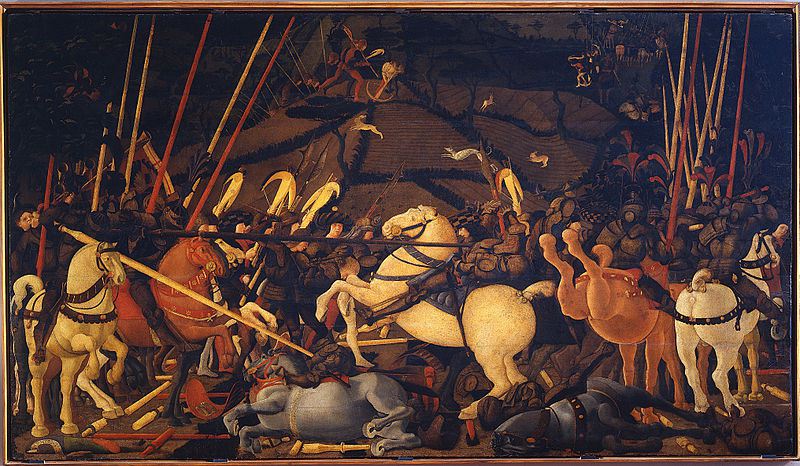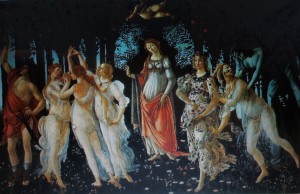How does an artist represent three dimensional space and an illusion of depth on a flat surface? One early example of how this can be done would be to look at the work of Paolo Uccello who was born in Florence in 1397, his father was a barber-surgeon, his mother a high-born Florentine. Uccello is his nickname, Paul of the birds, so named because he liked to paint birds and other creatures. He was a mathematician and painter and is remembered for his development of perspective, a method of producing a sense of space and depth in a painting, there are other ways such as with the use of colour. The Egyptian and Byzantine artists had totally disregarded perspective, Giotto in Italy had made some strides to obtain this sense in his wonderful murals, now we do not find it difficult to achieve providing we learn a few basic rules. It was not until the early Renaissance era that perspective was used , these years between the 14th and early 17th. centuries were a time that heralded the end of the Middle Ages, it is thought to have began in Florence. New knowledge focused through the developing natural sciences was sought and collected by philosophers, scientists and artists, this new approach was thought to have been brought by Greek scholars who fled from Constantinople when the Ottoman Turks concquered the city, they brought their texts and knowledge with them, Greek and Roman mythology was studied once again and would be again by artists like Picasso.
Uccello was so interested in solving the problem of perspective that he would stay up at night attempting to find vanishing points, he was an idiosynchratic character who had no school of followers although he influenced artists such as Piero della Francesco, Albert Durer and Leonardo da Vinci, his tutor was Ghiberti who designed the magnificent doors of the Florence Baptistry. Uccello married in 1453.
The Battle of San Romano was depicted in three panels painted over several years with egg tempera on wood, the battle was between Florence and Sienna which lasted for eight hours, the forces of Florence were the victors – Italy was not unified then. These paintings were a secular commission, most artists then worked mainly for patrons in the church and so did Uccello, this tryptich was admired later by Lorenzo de Medici who did much to foster the Arts, the Medici family were a powerful dynasty who ruled in Florence. I have chosen the middle panel painted between 1435 and 1455, the three panels were intended to be hung high on three walls, they are now separated, one is in the National Gallery I think, another in the Louvre in Paris and the one I have chosen is held in the Uffizi Gallery in Florence, each panel is about three metres long.
In this work we see a colourful pageant, a tournament rather than a real battle scene, Uccello was a mathematician with a purpose! In these paintings he exhibits his theories on perspective, he was not concerned with the feelings of the participants on the battlefield, the result is a rather wooden look to the characters, the horses could be rocking horses and the knights stuffed dummies, forms are foreshortened, we see a forest of lances and some are broken and lying on the ground as are two of the horses one with the knight still in the saddle, foot soldiers are bunched together in the middle distance, all methods used by Uccello to exhibit perspective as our eyes are led to the background, strangely there is a hunt also taking place across the fields. I like the use of the warm and rich colour, for the horse’s bridles he used gold leaf and for the armour silver leaf, which has tarnished over time. Uccello was a man of the Renaissance but as with many artists he also had knowledge the past, in this case earlier gothic art. The work is more like a fairy tale in pictures even though it depicts an historic violent event, I think that is why I like it.
Bernard Berenson, an art critic who wrote about Renaissance art in Italy was perhaps a little harsh when discussing Uccello’s work, he pointed out that art is not simply skill or a show of dexterity or to be used for scientific purposes, I would agree but Uccello did achieve what he set out to do, and as early example of perspective he was successful. Berenson worte ‘ Florentine art rushed to its end’ because of these failings, other schools of art in Italy prospered. Sadly Uccello went the same way, spending his latter years forgotten and lonely with a sick wife, he died in 1475.
Image from wikipedia,


